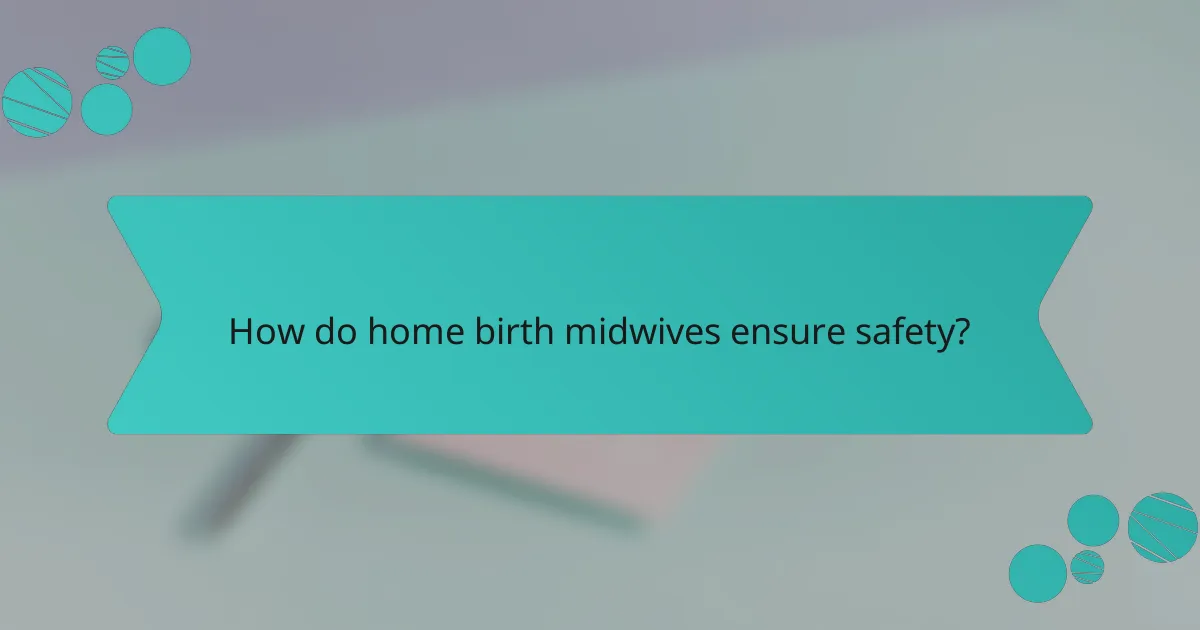Home birth midwives provide a unique birthing experience by offering personalized care in the comfort of your own home. They prioritize safety through thorough monitoring and emergency preparedness, ensuring a supportive environment throughout labor. Choosing a qualified midwife can enhance your confidence and comfort during this significant life event.

What are the benefits of home birth midwives?
Home birth midwives offer several advantages, including personalized care, comfort in familiar surroundings, and a focus on safety. These benefits can lead to a more positive birthing experience for families who choose this option.
Personalized care and attention
Home birth midwives provide individualized care tailored to each family’s needs. They often spend more time with expectant parents, allowing for in-depth discussions about preferences, concerns, and birthing plans.
This personalized approach fosters a trusting relationship, which can enhance the overall experience and reduce anxiety during labor and delivery.
Comfort of familiar surroundings
Giving birth at home allows families to remain in a familiar environment, which can significantly reduce stress. The comfort of home can create a calming atmosphere, making it easier for the birthing person to relax and focus on the process.
Being surrounded by personal belongings and loved ones can also contribute to a sense of security, which is beneficial during labor.
Reduced intervention rates
Home births typically have lower intervention rates compared to hospital births. Midwives are trained to support natural childbirth and often encourage minimal medical interventions unless absolutely necessary.
This approach can lead to fewer cesarean sections and other medical procedures, promoting a more natural birthing experience.
Enhanced emotional support
Home birth midwives provide continuous emotional support throughout labor and delivery. They are trained to recognize and respond to the emotional needs of the birthing person, offering reassurance and encouragement.
This emotional support can help reduce feelings of fear and anxiety, contributing to a more positive birth experience.
Increased family involvement
Home births allow for greater family participation in the birthing process. Partners and other family members can be actively involved, which can strengthen family bonds and create lasting memories.
Having loved ones present can also provide additional emotional support, making the experience more meaningful for everyone involved.

How do home birth midwives ensure safety?
Home birth midwives prioritize safety through comprehensive monitoring, emergency preparedness, and collaboration with healthcare facilities. They assess risks beforehand and maintain a supportive environment that promotes both comfort and security during labor.
Continuous monitoring during labor
Home birth midwives provide continuous monitoring of both the mother and baby during labor. This includes checking vital signs such as heart rate and blood pressure, as well as monitoring contractions to ensure progress is within a safe range.
Midwives often use portable equipment to track these metrics, allowing them to respond quickly to any changes. Regular assessments help identify potential issues early, ensuring timely interventions if necessary.
Emergency protocols and equipment
Home birth midwives are trained in emergency protocols to handle unexpected situations. They carry essential equipment, such as oxygen, resuscitation tools, and medications, to address complications that may arise during labor.
In the event of an emergency, midwives are prepared to implement life-saving measures while coordinating with local emergency services if hospital transfer becomes necessary. This preparedness enhances safety and provides peace of mind for families.
Collaboration with hospitals
Home birth midwives maintain strong relationships with local hospitals to ensure seamless transitions if complications occur. They often have established protocols for transferring patients, which can significantly reduce response times in emergencies.
Midwives communicate with hospital staff about the mother’s medical history and labor progress, facilitating a smooth handover if hospital care is required. This collaboration reinforces a safety net for home births.
Risk assessment before birth
Before labor begins, midwives conduct thorough risk assessments to determine if a home birth is appropriate. This evaluation includes reviewing the mother’s health history, current pregnancy conditions, and any previous birth experiences.
Based on this assessment, midwives can identify potential risks and make informed decisions about the safety of a home birth. If any concerns arise, they will discuss alternatives, ensuring the best possible outcome for both mother and baby.

What should I consider when choosing a home birth midwife?
When selecting a home birth midwife, prioritize their qualifications, experience, and availability to ensure personalized care and safety during your birthing experience. Understanding these factors will help you make an informed decision that aligns with your birth plan and comfort level.
Qualifications and certifications
Verify that the midwife holds relevant qualifications and certifications, such as being a Certified Professional Midwife (CPM) or a Licensed Midwife (LM). These credentials indicate that they have undergone specific training and adhere to established standards of care.
Additionally, check if they are registered with local health authorities or professional organizations, which can provide further assurance of their competence and adherence to safety regulations.
Experience with specific birth plans
Discuss your birth plan with potential midwives to gauge their experience with similar situations. Some midwives specialize in certain types of births, such as water births or VBACs (vaginal birth after cesarean), so ensure their expertise aligns with your preferences.
Ask about their approach to managing complications and how they collaborate with other healthcare providers, as this can impact the safety and success of your home birth.
Availability and support options
Confirm the midwife’s availability around your due date and inquire about their support options during labor and postpartum. Some midwives offer continuous support, while others may have a backup midwife who can assist if needed.
Understanding their on-call schedule and how they handle emergencies will help you feel more secure about your choice.
Client testimonials and reviews
Look for testimonials and reviews from previous clients to gain insight into the midwife’s care style and effectiveness. Positive feedback can indicate a strong track record of successful home births and satisfied families.
Consider reaching out to former clients directly if possible, as personal recommendations can provide valuable perspectives on their experiences with the midwife.

What are the costs associated with home birth midwives?
The costs of hiring home birth midwives can vary significantly based on location, services offered, and individual midwife practices. Generally, expect to pay anywhere from a few thousand to several thousand dollars for comprehensive care throughout pregnancy, labor, and postpartum support.
Average fees in major cities
In major cities, the average fees for home birth midwives typically range from $3,000 to $6,000. For example, in New York City, costs can be on the higher end, while cities like Austin may offer more affordable options. It’s essential to research local midwives to get a clearer picture of what to expect in your area.
Insurance coverage options
Insurance coverage for home birth midwives varies by provider and plan. Some insurance companies may cover a portion of the costs, especially if the midwife is a licensed provider. Check with your insurance company to understand your specific coverage and any necessary documentation required for reimbursement.
Payment plans and financial assistance
Many home birth midwives offer flexible payment plans to make their services more accessible. This can include monthly payment options or sliding scale fees based on income. Additionally, some organizations provide financial assistance or grants for families seeking home birth services, so explore local resources that may be available to you.

How do home birth midwives compare to hospital births?
Home birth midwives offer a distinct alternative to hospital births, focusing on personalized care and the comfort of home. While both options prioritize safety, the approach and environment can significantly differ, impacting the overall experience for the mother and baby.
Differences in care models
Home birth midwives typically provide a model of care that emphasizes continuity and personalized attention. This often includes regular prenatal visits in the comfort of the mother’s home, allowing for a more relaxed atmosphere. In contrast, hospital births may involve multiple caregivers and a more clinical setting, which can affect the emotional experience of labor and delivery.
Midwives often take time to discuss birth plans, preferences, and concerns, fostering a collaborative relationship. This personalized approach can lead to tailored support during labor, such as using non-medical pain relief techniques and encouraging mobility, which may not be as readily available in a hospital environment.
Outcomes and satisfaction rates
Research indicates that planned home births attended by qualified midwives can have outcomes comparable to hospital births for low-risk pregnancies. Many women report higher satisfaction rates with home births, citing the comfort of familiar surroundings and the individualized care received from their midwives.
However, it is crucial for expectant mothers to assess their individual health circumstances and preferences. Engaging in thorough discussions with healthcare providers can help determine the safest and most satisfying option for their specific situation. In some cases, a hospital birth may be more appropriate, especially for higher-risk pregnancies.
